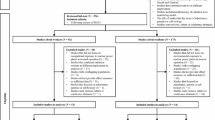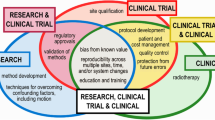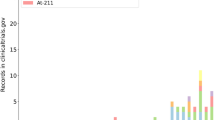Abstract
Despite the considerable importance of accurately estimating the respiration regularity of a patient in motion compensation treatment, not to mention the necessity of maintaining that regularity through the following sessions, an effective and simply applicable method by which those goals can be accomplished has rarely been reported. The authors herein propose a simple respiration regularity index based on parameters derived from a correspondingly simplified respiration model. In order to simplify a patient’s breathing pattern while preserving the data’s intrinsic properties, we defined a respiration model as a cos4(ω(t) · t) wave form with a baseline drift. According to this respiration formula, breathing-pattern fluctuation could be explained using four factors: the sample standard deviation of respiration period (s f ), the sample standard deviation of amplitude (s a ) and the results of a simple regression of the baseline drift (slope as β, and standard deviation of residuals as σ r ) of a respiration signal. The overall irregularity (δ) was defined as \(\left\| {\vec \omega } \right\|\), where \(\vec \omega \) is a variable newly-derived by using principal component analysis (PCA) for the four fluctuation parameters and has two principal components (ω 1, ω 2). The proposed respiration regularity index was defined as ρ = ln(1 + (1/δ))/2, a higher ρ indicating a more regular breathing pattern. We investigated its clinical relevance by comparing it with other known parameters. Subsequently, we applied it to 110 respiration signals acquired from five liver and five lung cancer patients by using real-time position management (RPM; Varian Medical Systems, Palo Alto, CA). Correlations between the regularity of the first session and the remaining fractions were investigated using Pearson’s correlation coefficient. Additionally, the respiration regularity was compared between the liver and lung cancer patient groups. The respiration regularity was determined based on ρ; patients with ρ < 0.3 showed worse regularity than the others whereas ρ > 0.7 was suitable for respiratory-gated radiation therapy (RGRT). Fluctuations in the breathing cycle and the amplitude were especially determinative of ρ. If the respiration regularity of a patient’s first session was known, it could be estimated through subsequent sessions. Notably, the breathing patterns of the lung cancer patients were more irregular than those of the liver cancer patients. Respiration regularity could be objectively determined by using a composite index, ρ. Such a single-index testing of respiration regularity can facilitate determination of RGRT availability in clinical settings, especially for free-breathing cases.
Similar content being viewed by others
References
K. M. Langen and D. T. Jones, Int. J. Radiat. Oncol. Biol. Phys. 50, 265 (2001).
P. J. Keall et al., Med. Phys. 33, 3874 (2006).
A. Krauss, S. Nill and U. Oelfke, Phys. Med. Biol. 56, 5303 (2011).
D. Ruan, J. A. Fessler and J. M. Balter, Med. Phys. 35, 782 (2008).
G. C. Sharp, S. B. Jiang, S. Shimizu and H. Shirato, Phys. Med. Biol. 49, 425 (2004).
D. Verellen, T. Depuydt, T. Gevaert, N. Linthout, K. Tournel, M. Duchateau, T. Reynders, G. Storme, and M. De Ridder, Cancer Radiother. 14, 446 (2010).
M. Hoogeman, J. B. Prevost, J. Nuyttens, J. Poll, P. Levendag and B. Heijmen, Int. J. Radiat. Oncol. Biol. Phys. 74, 297 (2009).
E. W. Pepin, H. Wu, Y. Zhang and B. Lord, Med. Phys. 38, 4036 (2011).
F. Ernst, Compensating for Quasi-Periodic Motion in Robotic Radiosurgery, (Springer, New York, 2012).
S. H. Benedict et al., Med. Phys. 37, 4078 (2010).
W. Lu, P. J. Parikh, J. P. Hubenschmidt, J. D. Bradley and D. A. Low, Med. Phys. 33, 2964 (2006).
P. S. Verma, H. Wu, M. P. Langer, I. J. Das and G. Sandison, Comput. Sci. Engin. 13, 24 (2011).
H. Shirato, Y. Seppenwoolde, K. Kitamura, R. Onimura and S. Shimizu, Semin. Radiat. Oncol. 14, 10 (2004).
S. S. Vedam, P. J. Keall, V. R. Kini, H. Mostafavi, H. P. Shukla and R. Mohan, Phys. Med. Biol. 48, 45 (2003).
D. Ruan, J. A. Fessler, J. M. Balter and P. J. Keall, Phys. Med. Biol. 54, 4777 (2009).
F. Ernst, A. Schlaefer and A. Schweikard, Med. Phys. 38, 5569 (2011).
M. W. Kissick, X. Mo, K. C. McCall, L. K. Schubert, D. C. Westerly and T. R. Mackie, Phys. Med. Biol. 55, 2983 (2010).
Y. D. Mutaf, J. A. Antolak and D. H. Brinkmann, Med. Phys. 34, 1615 (2007).
S. Nishioka, T. Nishioka, M. Kawahara, S. Tanaka, T. Hiromura, K. Tomita and H. Shirato, Radiother. Oncol. 86, 69 (2008).
S. Vedam, L. Archambault, G. Starkschall, R. Mohan and S. Beddar, Med. Phys. 34, 4247 (2007).
http://www.Rob.Uni-Luebeck.De/Node/117#downloads.
F. Ernst and A. Schweikard, Int. J. CARS. 3, 85 (2008).
F. Ernst and A. Schweikard, Int. J. Comput. Assist. Radiol. Surg. 4, 439 (2009).
D. Ruan, Phys. Med. Biol. 55, 3885 (2010).
G. C. Sharp, Q. Zhao, H. Shirato and S. B. Jiang, Phys. Med. Biol. 52, 4761 (2007).
S. S. Vedam, P. J. Keall, A. Docef, D. A. Todor, V. R. Kini and R. Mohan, Med. Phys. 31, 2274 (2004).
K. C. McCall and R. Jeraj, Phys. Med. Biol. 52, 3455 (2007).
Author information
Authors and Affiliations
Corresponding author
Rights and permissions
About this article
Cite this article
Cheong, KH., Lee, M., Kang, SK. et al. Evaluation of breathing patterns for respiratory-gated radiation therapy using the respiration regularity index. Journal of the Korean Physical Society 66, 301–313 (2015). https://doi.org/10.3938/jkps.66.301
Received:
Published:
Issue Date:
DOI: https://doi.org/10.3938/jkps.66.301




